On March 27, there were three pallas’ cat kittens born to proud parents Sofiya and Buster. Pallas cats, otherwise known as manul, live in the mountains of central Asia.
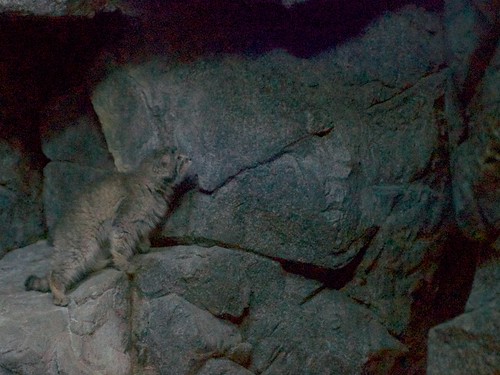
They are about the size of a domestic cat, though much fluffier.
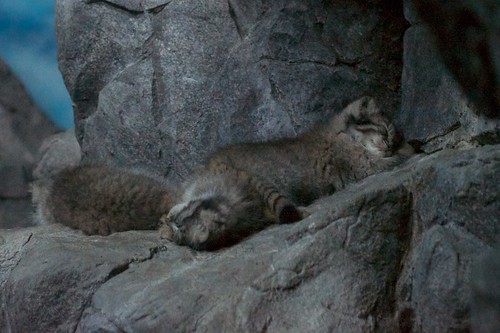
Working for the smaller wild cats
The Alberta Conservation Association is running an extensive Wolverine (Gulo gulo) research project in the Rocky Mountains. Sometimes their camera traps pick up unexpected wildlife action.
24 hours, 3 cougars, 4590 photos – all of this together creates one cool cougar video! Together with the Alberta Trappers Association, we do a lot of wolverine research that includes monitoring tree stands. Some cougars decided to take over one stand in particular with hopes of gaining a free meal. Click the box on the bottom right of the video to watch these determined cats in full screen!
To learn more about wolverines and the research ACA does with them, check out this article written by one of their biologists: http://bit.ly/11lVv4J.
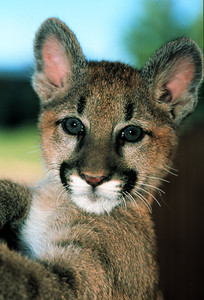 During late spring and summer, one to two year old cougar become independent of their mothers. While attempting to find a home range, these young cats often roam widely in search of an unoccupied territory. This is when they are most likely to come into contact with people.
During late spring and summer, one to two year old cougar become independent of their mothers. While attempting to find a home range, these young cats often roam widely in search of an unoccupied territory. This is when they are most likely to come into contact with people.
This time of year means more people in cougar territory, and more wandering young cats. If you plan to visit cougar country, please familiarize yourself with these tips before hitting the trails. Cougar are predators at the top of the food chain, and their actions are often unpredictable. Following these general guidelines will reduce the risk of cougar conflict.
If you meet a cougar DO NOT RUN. Back away slowly, always looking them in the eye. Sudden movement or flight may trigger an instinctive attack.
Never turn your back on a cougar – face the cat and remain upright
Do all you can to make yourself look bigger. Hold a coat, branch or any other object over your head, or wave it around. Don’t crouch down or try to hide
Yell, throw rocks, speak loudly and firmly. Convince the cougar that you are a threat, not prey
Always give the cougar an avenue of escape
If the cat attacks FIGHT BACK. Many people have survived cougar attacks by fighting back with anything they have, including rocks, sticks, fists, fishing poles, cameras etc
Hiking in Cougar Country
Hiking with Children
More information on our Safety in Cougar Country page
On December 31, 2012, an ocelot was born at the Cincinnati Zoo.
The mother was impregnated using a new laparoscopic oviductal artificial insemination technique.
Now five months old, Reveillon is enjoining romping with her mother, Sala.
ISEC Canada has the most wonderful members! So many of them are always going out of their way to do something special for the small cats.
Last Friday was Endangered Species Day, and we received a phone call from member David Cohn. Already a generous supporter of the small cats, he wanted to make an additional donation on behalf of his wife Amy’s birthday.
We’ve been saving this beautiful photo for the right occasion. As David and Amy are fans of the Pallas’ Cat, we felt this was the perfect choice to wish Amy Cohn a Happy Birthday from ISEC Canada and the small wild cats! Thank you David and Amy for your concern about the future of the small felids.
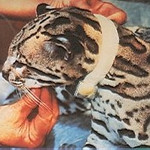 Ocelots once ranged from Mexico up into the southern states, including Texas, Arizona, Arkansas and Louisiana. Today there are an estimated 50 of these small cats remaining in the USA, including a breeding population found in South Texas on the Laguna Atascosa National Wildlife Refuge. While there have been several ocelot sightings in Arizona recently, all of them were wandering males and there is no evidence of their breeding in that state.
Ocelots once ranged from Mexico up into the southern states, including Texas, Arizona, Arkansas and Louisiana. Today there are an estimated 50 of these small cats remaining in the USA, including a breeding population found in South Texas on the Laguna Atascosa National Wildlife Refuge. While there have been several ocelot sightings in Arizona recently, all of them were wandering males and there is no evidence of their breeding in that state.
Phantom Cat of the Chaparral: Endangered Ocelot is a stunning 30 minute documentary that explains the critical work being done by land owners and biologists to save these cats. Released by the US Fish and Wildlife Southwest Region, it provides rare footage and tells the important story of what is being done.
An important addition to education efforts for these endangered cats, we’ve added it as a permanent page in our Cat Conservation section.
Give yourself a short break, sit back and relax with the ocelots in Texas!
ISEC Canada member Phil Perry was fortunate to watch this beautiful Serval hunting. It managed to catch three rodents in half an hour. Photo taken in the Shamwari Game Reserve, South Africa.
These long-legged cats are found in well-watered savannah grass habitats of sub Saharan Africa. The serval specializes in small mammals, with 90% of their diet weighing less than 200 grams. They have a characteristic high pounce when hunting which can reach heights of up to two meters high and 4 metres long.
One study found they have a hunting success rate of 49% in almost 2000 pounces. They killed 15-16 times in 24 hours, making 0.8 kills per hour.
That’s a lot of rodents that could have been destroying crops or invading villages. Another very important reason to protect small wild cats!
Dear friends of AGA:
After a southern summer break, we gladly send our newsletter to let you know about the activities that AGA members are developing. We offer fresh news and of follow-up actions initiated in the last year or before. We hope you enjoy them and thank you again for letting us to get into your screens.
M. Lilian Villalba
AGA General Coordinator
Linking Research To Action
By: Rocío Palacios

Everything evolves, and conservation is not an exception. During past years there has been a trend inside the Alliance that went from research oriented projects to conservation exclusive proposals. Both kinds of projects have strengths and weaknesses, but there is one common aspect between them: we need both for properly conserving the Andean cat and its landscape.
Now in the Alliance most projects look for a way to combine some needed research and conservation. We believe that this combined approach of research and action is more than a necessity, is the only real way to make conservation effective in this globalized and accelerated world.
We need research, we need to know what the species need, to be able to conserve them better. We also urgently require effective conservation actions, and that means it is not possible to wait until research provides results, while we wait we can start applying some mitigation actions. The perfect combination is to use one to help the other: while doing conservation also doing research and vice versa. This is the only way we can preserve our wild cats, while discovering their long kept secrets.
New Record of Andean Cat Expansion 650 km to the South in Chile!
By: Agustín Iriarte, Cristian Sepúlveda, Nicolas Lagos
Employees of the mining company Caserones managed to photograph and film a specimen of Andean cat at 120 km from the city of Copiapó. This arid area is located at an elevation of 2200 m asl in the Andes of Atacama Region that is characterized by a Mediterranean climate. This record extends the distribution range of the Andean cat, moving its border 650 km to the south from the southernmost known record in the Puritama canyon, in the north of San Pedro de Atacama. Additionally, this is also the lowest altitude record for Chile, because all other previous records were at more than 3600 m asl. This information was kindly provided by Yamal Suez (Caserones chief of the environmental area) and the person in charge of natural resources of Atacama SAG (Jose Andaur).

Collared Cats!
By: Juan Reppucci
Thirty two days after her capture we obtain a camera trap photo of Vichacha, a female Andean cat, wearing her radiocollar. The picture was taken at around 4.5 kilometers from the capture spot, in the top part of a big canyon where we also obtain pictures of rheas, vicuñas and foxes. Several months before her capture we had obtained many pictures of Vichacha with her kitten in the capture spot. Recognize her was easy, using the coat pattern as we usually do, but also the characteristics dreadlocks that she has on her back close to the tail. Close to the border and in one of the highest points of the study area we obtain a picture of Alexander Supertramp, a male Pampas cat, after five days of his capture, at around four kilometers away. Camera traps, in addition to radio-collars, are important tools for monitoring these cats.

Conservation and Sustainable Management of Habitats, Peru
By: Dina Farfán
This project is the result of a research conducted on the Andean Cat and its habitat since 2003 in Cusco Region. In 2008 we coordinated with six communities located at the south east of the Ausangate glacier, to create conservation areas in their territories, taking the Andean cat and wetlands as the main conservation objectives.
As a working strategy we developed an integral program of conservation, sustainable management, education and capacity building; in the last year, to encourage the participation of the communities, we worked for developing projects that provide direct economic benefits. After a comprehensive assessment, we have supported the development of a Plan of Tourism and Recreation Use, and other tools to enable communities to implement an ecotourism program, which is characterized for being managed by them and with high environmental and social responsibility. Currently we continue to support them, so that the Peruvian State recognizes the zone as a Chilca Private Conservation Area. In addition to the contributions that AGA and WCN have given ro the development of this project, we also had technical and financial support from ACEMAA and APTAE.
 |
 |
Global Actions to Guarantee a Future to the Andean Cat
By: Maria José Merino y Alejandra Torrez

The project Andean Cat Global Action (ACGA) is a cross-border initiative, where the four range countries of the Andean cat co-operate to consolidate the profile of this cat as a flagship species across its whole distribution range and, consequently, to strengthen the conservation of biodiversity in the regions where it occurs.
To achieve these goals, ACGA aims to develop a novel global strategy for education and community participation based on an itinerant exhibition and other new awareness materials that will be distributed widely, both to the local communities and the general public. In the first year, we devoted a large effort to agree the best strategies and design the education material that was planned. We produced a common poster, a brochure promoting AGA work and, banners used in the itinerant exhibition that is the core awareness tool. We delivered environmental education activities to a total of 236 children and 29 teachers in cooperation with a number of partner organizations. Additionally, we are working among local communities, to collect stories on the Andean cat that we will use for a booklet to be published soon.
Trails of Inquiry: A Methodology for Conservation Education
By: Daniela Ulloa

AGA and the Center for Studies in Theoretical and Applied Biology-BIOTA, are running the project “Trails of inquiry: reflecting on our environment,” in the Municipal Botanical Garden Ema-Verde, Municipal Zoo “Vesty Pakos” and the National Natural History Museum in the city of La Paz, Bolivia.
In December 2012, we began with the training of 25 volunteers in a methodology called “Trails of inquiry” through a workshop provided by Dr. Peter Feinsinger and Iralys Ventosa and a group of collaborators from Argentina and Bolivia. This methodology consists of routes that use elements of the environment in order that a guide, a sign or a brochure induce the visitor to perform “Cycles of inquiry” of firsthand, brief but complete, about specified elements in the immediate environment. The “Cycle of Inquiry” is based on the practice of the scientific method but in simplified form and involves three basic steps: question, action and reflection.
In this pilot initiative, both volunteers and visitors discover educational experiences to interact with each other, deal with new challenges and different ways of interpreting the environment. The Trails of inquiry can be applied in different contexts; certainly, these experiences will be a guide for planning educational strategies for the conservation of the Andean cat in its environment.
SHOWCASTING OUR MEMBERS: Rocío Palacios
By: Susan Walker

Rocio Palacios is passionate about cats! This passion has led her to dedicate her career to the protection and study of Argentina’s wild felines, especially the Andean cat. As an undergraduate in biology, Rocío carried out research on Patagonia’s cats and canids. Even before graduating she began working for the Wildlife Conservation Society’s Patagonian Steppe program, forming part of the team that discovered the Andean cat in San Juan, Argentina, in 2003.
After leaving WCS to do graduate work, she developed a program to train park rangers in monitoring and conservation of Patagonian carnivores, and printed a manual that has been widely distributed to rangers and local people. She has led workshops based on this material in different provinces, the national parks, and private reserves.
Active since 2005 in the Andean Cat Alliance, she has served in several administrative capacities, including that of general coordinator for two years. Her current doctoral research on the Andean cat in northern Patagonia will provide crucial input to develop conservation plans for the southernmost population of the species.
Andean Cat Alliance (Alianza Gato Andino) website
by W. Angermeyer
Originally published on our Felids blog February 14, 2013
Before moving on in my series of posts on conservation programs for endangered captive cats, I would like to go in to a bit more depth on the American Association of Zoo’s and Aquariums (AZA) conservation programs to provide some updated information and answer some questions we received.
In the past couple of years, the AZA has made some changes and they are phasing out Population Management Programs (PMPs). All of them have been changed to Species Survival Plans (SSPs) which are now designated as one of three colors: green, yellow and red. If an SSP is green, that means that the population in captivity is predicted to be sustainable with a high percentage of genetic diversity (at least 90%) for at least the next 100 years based on genetic analyses. If an SSP is yellow, then the population of that species in AZA zoos is OK now but is not sustainable. These populations need work if we want the species to persist in zoos long-term. Finally, red SSPs are populations that are nowhere near sustainable (less than 50 individuals with poor genetic diversity) and need a lot of help or may be extinct in zoos in the very near future.
Yellow: Caracal, Serval, Amur Leopard, Canada Lynx, Cheetah, Snow Leopard, Ocelot, Puma, Clouded Leopard, Bobcat, Jaguar, Black-footed Cat
Green: Lion,Tiger
Red: Fishing Cat, Sand Cat, Pallas’ Cat
The original purpose of an SSP was to get zoos to communicate and cooperate when managing animals to ensure that the captive population of each species was healthy so zoos weren’t constantly taking animals out of the wild or inbreeding to produce individuals. Genetics certainly played a big role in influencing this purpose. Now the purpose (also genetics driven) is to achieve sustainability within the captive population so that we have healthy populations in the long-term. One reason is to have a reserve of animals to help supplement the wild population in case it is ever necessary. Although zoos and researchers still have much to learn about how to effectively reintroduce animals back into the wild, the possibility to do so is a goal and is a reality for some SSPs such as the Mexican Wolf, Whooping Cranes, Vancouver Island Marmots or the Amur leopard. An SSP species may not be considered endangered in the wild but might require better management in captivity to improve the genetics of the captive population.
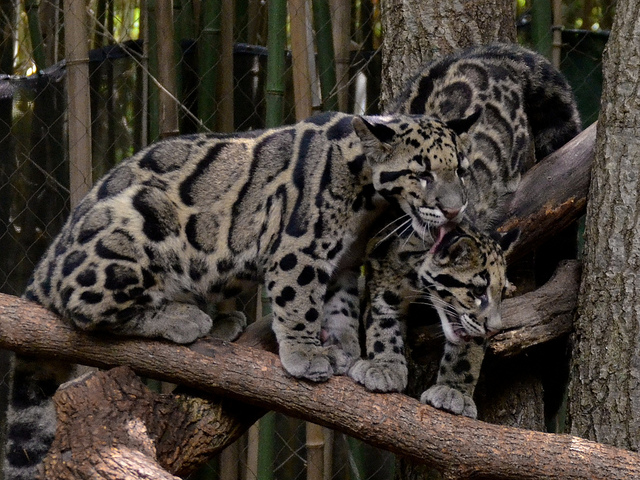
Captive individuals that are part of an SSP breeding program may or may not be on public exhibit depending on the availability of space at the institution. A shortage of space tends to be more of an issue with mammalian species. Some institutions do have off-exhibit space and utilize this space as necessary. Whether or not breeding stock will be on exhibit depends on how imperative privacy is for breeding and births. If public display is detrimental, then it will be a priority for off-exhibit space to be created. A lot of species that zoos have had success with breed fine while on exhibit. Each individual animal’s temperament would need to be considered as well. For zoos in temperate or sub-arctic climates, there would also be seasonal considerations and limitations for housing.
It could be said that all AZA institutions participate in all SSP programs because at some point they are likely to communicate about an SSP species such as when they are considering bringing in a new species They must agree to follow the rules of the SSP which vary according to the color designation. For example, all AZA zoos have to follow the breeding and transfer recommendations of a green SSP (however, keep in mind that recommendations are never made without considering the wishes and wellbeing of each zoo). Zoos are not forced to follow the recommendations of yellow or red SSPs if they choose not to, but it is strongly encouraged. Any zoo housing an individual member of an SSP species participates to some degree in the program.
Lastly, there was a question regarding fundraising for SSP animals regardless of whether the institution houses that SSP species. Any zoo may fund raise for any species regardless of whether there is an SSP designation for that species and any SSP can (and with the exception of extenuating circumstances probably will) accept funds raised by anyone regardless of whether they are an AZA accredited organization.
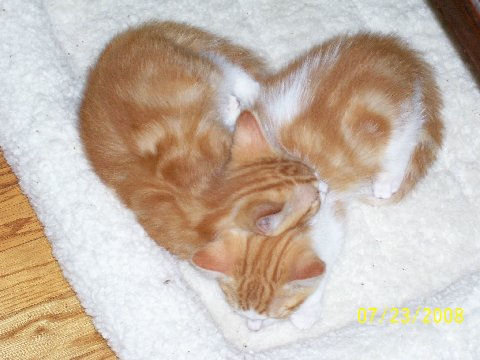
So in short, I guess you can think of the AZA Felid Tag as a very complex and involved dating service for cats. I wonder if there are some cats out on blind dates or taking the plunge in an arranged marriage for Valentine’s Day?
Thanks for providing updated information to:
– Dan Dembiec from the Jacksonville Zoo, Serval SSP Coordinator/Studbook Keeper and a Felid TAG Steering Committee Member
– Pam Pritchard, Animal Collection Specialist at the Calgary Zoo